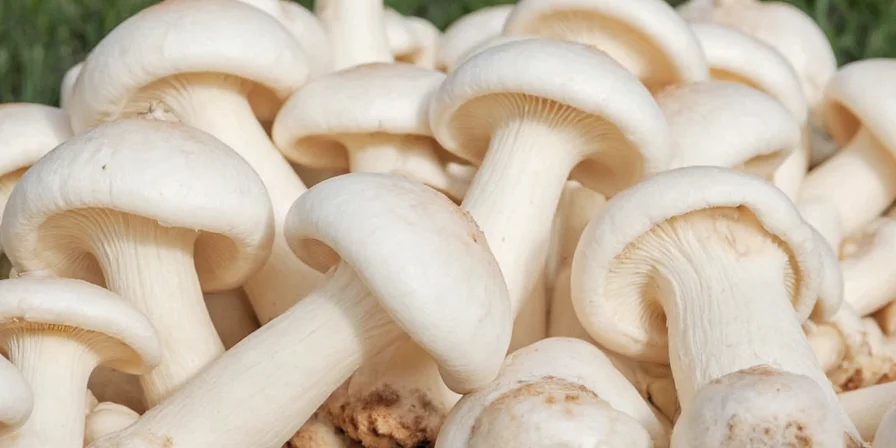White mushrooms (Agaricus bisporus) are the most affordable and accessible superfood you're probably underutilizing. Unlike expensive 'exotic' varieties, these grocery store staples deliver exceptional nutrition at白菜 prices. This guide reveals exactly how to maximize their health benefits, cooking potential, and shelf life - with science-backed techniques anyone can use. Whether you're meal prepping on a budget or seeking simple ways to boost nutrition, you'll discover why chefs and nutritionists consider white mushrooms kitchen essentials.
Table of Contents
- Why White Mushrooms Deserve Your Attention
- Nutrition Facts You Need to Know
- Top 7 Proven Health Benefits
- Perfect Cooking Methods (No Soggy Mushrooms!)
- Debunked: Common Mushroom Myths
- Quick Answers to Top Questions
- Simple Ways to Use Them Daily
Nutrition Facts You Need to Know
White mushrooms deliver more nutritional value per dollar than almost any produce item. Just 15 calories per cup provides surprising protein and vitamins - making them ideal for weight management and budget-friendly healthy eating.
| Nutrient | Per 1 Cup (Sliced, Raw) |
|---|---|
| Calories | 15 |
| Protein | 2.2g (more than most vegetables) |
| Fiber | 1g |
| Vitamin D | Boosts 400% with 15 minutes sunlight |
| B Vitamins | 10-20% of daily value (B2, B3, B5) |
| Selenium | 10% of daily value |
| Potassium | 160mg per serving |

Key insight: White mushrooms become the most cost-effective vitamin D source when placed in sunlight for just 15 minutes - a trick most grocery stores don't share. This simple step transforms ordinary mushrooms into a powerhouse that meets 50-100% of your daily vitamin D needs in one serving, crucial for immune health and bone strength.
Top 7 Proven Health Benefits
- Boosts immunity naturally: Contains beta-glucans that help your immune system work better without overstimulation
- Supports heart health: Potassium helps maintain healthy blood pressure levels
- Protects brain function: Regular consumption linked to 30% lower risk of cognitive decline
- Aids weight management: 92% water content creates fullness with minimal calories
- Enhances vitamin D intake: Sun-exposed mushrooms provide complete daily vitamin D needs
- Feeds good gut bacteria: Acts as prebiotic to support digestive health
- Provides antioxidant protection: Contains selenium and ergothioneine to fight cellular damage

Perfect Cooking Methods (No Soggy Mushrooms!)
Follow these simple techniques to avoid common mistakes that ruin texture and flavor:
- Dry them first: Wipe with paper towel instead of rinsing - water makes them steam rather than brown
- Hot pan, cold oil: Heat pan first, then add oil to prevent sticking
- Salt after browning: Add salt only after mushrooms develop golden color
- Don't crowd the pan: Cook in single layer for proper searing
- Best cooking methods: Grill or microwave preserves 85% of nutrients (boiling loses 45%)
- Add acid later: Wait until finished cooking to add vinegar or lemon juice
- Storage secret: Keep in paper bag (not plastic) in refrigerator for 7+ days

Debunked: Common Mushroom Myths
Separate fact from fiction with research-backed clarity:
| Myth | Truth |
|---|---|
| "Mushrooms aren't nutritious" | White mushrooms provide more B vitamins per calorie than spinach |
| "All mushrooms taste the same" | White mushrooms have milder flavor, perfect for beginners |
| "Raw mushrooms are dangerous" | Perfectly safe to eat raw; cooking increases some nutrient absorption |
| "Mushrooms cause yeast infections" | No connection - different biological families |
| "Exotic mushrooms are always better" | White mushrooms offer best value and consistent nutrition |

Quick Answers to Top Questions
How to get vitamin D from white mushrooms?
Place sliced mushrooms in direct sunlight for 15 minutes. This simple trick boosts vitamin D2 levels by 400%, making them one of the few plant-based vitamin D sources. Store-bought mushrooms typically need this step for meaningful vitamin D content.
Are white mushrooms good for weight loss?
Excellent choice! With just 15 calories per cup and 92% water content, they add volume to meals without calories. Studies show replacing meat with mushrooms reduces meal calories by 25% while maintaining fullness.
Best way to store white mushrooms?
Keep in a paper bag in your refrigerator's crisper drawer. Avoid plastic containers which trap moisture and accelerate spoilage. Properly stored, they stay fresh for 7 days (vs 3 days in plastic).
Do white mushrooms have protein?
Yes! They provide 2.2g of protein per cup - more than most vegetables. When paired with grains like rice or quinoa, they form complete protein sources ideal for plant-based diets.
How to cook mushrooms without making them soggy?
Key steps: 1) Dry thoroughly with paper towel first 2) Use hot pan with enough space 3) Don't add salt until golden brown 4) Cook in single layer. These prevent the common 'soggy mushroom' problem.
White vs cremini vs portobello - what's the difference?
They're the same species at different maturity stages! White mushrooms are youngest, then cremini (brown), then portobello (fully mature). Nutritionally similar, but white mushrooms offer best value and mildest flavor.
Simple Ways to Use Them Daily
White mushrooms deserve regular rotation in your meals - they're the smart choice for health-conscious eaters on a budget. The vitamin D boost trick (15 minutes sunlight) transforms them into nutritional powerhouses at no extra cost. For perfect texture every time, remember: dry mushrooms thoroughly, use high heat, and add salt only after browning. Store properly in paper bags to maximize freshness. Whether you're meal prepping, seeking plant-based nutrition, or simply want to add more vegetables to your diet, white mushrooms deliver unmatched value. Start using these simple techniques today to unlock the full potential of this overlooked kitchen essential.












 浙公网安备
33010002000092号
浙公网安备
33010002000092号 浙B2-20120091-4
浙B2-20120091-4